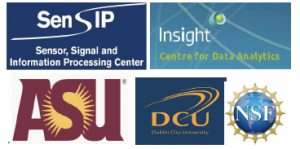Sample IRES Projects at ASU and DCU
We present below a few sample projects inspired by research capabilities at ASU and DCU. More faculty and additional projects will be defined for participating students.
Sample Projects at ASU for the IRES
Sensor Device and Flexible Circuit Design for Health Monitoring and Wearables
 Our IRES faculty have an unmatched depth and breadth of experience in sensor and flexible circuit and sensor development. The BBC has expertise from physics, chemistry and engineering to create multi-disciplinary teams to address research in Biosensors and Electronics for Biomarker Detection that can be used to indicate a person’s health status.
Our IRES faculty have an unmatched depth and breadth of experience in sensor and flexible circuit and sensor development. The BBC has expertise from physics, chemistry and engineering to create multi-disciplinary teams to address research in Biosensors and Electronics for Biomarker Detection that can be used to indicate a person’s health status.
The BBC has expertise from physics, chemistry and engineering to create multi-disciplinary teams to address research in Biosensors and Electronics for Biomarker Detection that can be used to indicate a person’s health status. Designing biosensors along with their electronics for detection of biomarkers will lead to prediction, prevention and early diagnosis. Challenges to be addressed in this area include: (a) Use of nano-structured material to build fully-integrated sensors for monitoring; (b) Development of non-invasive chemical and bio-inspired mobile sensors; (c) Use of inexpensive sensors and mobile devices together with DSP and ML for diagnosis; and (d) fabrication. Contact: Erica Forzani
Development of Algorithms and Software for Information Extraction from Sensors
IRES faculty at ASU and DCU in signal processing and ML include engineers, mathematicians and computer scientists who are established leaders with capabilities in machine learning and sensor fusion algorithms. Integrated design of sensors and “corrective” algorithms using collaborative signal processing and big-data analytics are key to achieving compactness, mobility, remote sensing, and precise instrumentation with inexpensive sensors.
 Fundamental challenges in this area include: (a) Efficient integration of algorithms/software with sensor hardware; (b) Extraction of parameters and features from big-data using machine learning; (c) Image processing for diagnosis and health analytics; (d) Data fusion algorithms to improve the probability of positive detection; (e) Algorithms for storage, processing, data integrity, and security of big-data systems; and (f) Development of interfaces for mobile devices and wearables. Contact G. Raupp, A. Spanias
Fundamental challenges in this area include: (a) Efficient integration of algorithms/software with sensor hardware; (b) Extraction of parameters and features from big-data using machine learning; (c) Image processing for diagnosis and health analytics; (d) Data fusion algorithms to improve the probability of positive detection; (e) Algorithms for storage, processing, data integrity, and security of big-data systems; and (f) Development of interfaces for mobile devices and wearables. Contact G. Raupp, A. Spanias
Mobile Sensor and Biomedical Information Management and Visualization
Biomedical informatics at ASU and DCU have a strong body of work in biomedical informatics. Biomedical Information from sensors processed by DSP algorithms has to be managed appropriately to provide mobile diagnostics for disease prevention. Applications will include Care Testbeds. studies on how social networks can engage mobile health technologies with collaborative social features. The power of social networks in sharing information with global population will be explored. Challenges include: (a) Human-Machine Interface Design and Visualization of biosensor data; (b) Developing human-computer devices for personal biosensors; and (c) Access and integrity of electronic medical records via mobile devices.
Embedding Deep Learning and Big Data Algorithms in Sensor Platforms
Our teams at ASU and DCU have a strong body of algorithms in ML, signal processing and big data. One of the goals of this IRES program is to produce “tiny” ML algorithms for embedded sensor systems (“ML at the edge”).
 For example, can one prune algorithms or quantize neural nets such that they can be embedded in mobile devices. This is an area of high interest and a recent workshop in the silicon valley organized by Google, Samsung, and Qualcomm addressed specifically these topics.
For example, can one prune algorithms or quantize neural nets such that they can be embedded in mobile devices. This is an area of high interest and a recent workshop in the silicon valley organized by Google, Samsung, and Qualcomm addressed specifically these topics.
Work at the ASU SenSIP center, focused on embedding ML algorithm training and clustering on a compact NXP board for IoT applications. On the other hand, work funded by the NCSS I/UCRC produced a deep neural net algorithm that can be quantized for implementation at the edge. This approach saves memory and power. The ASU-DCU synergy will explore using these algorithms for biomedical and sensor applications in activity modeling. Challenges include: a) can deep learning be implemented at the edge, b) embedding compact ML algorithms in wearables without appreciable loss of accuracy, c) using ML and big data algorithms in a secure privacy-preserving manner. Contact A. Spanias
Sample Projects at DCU for the IRES
The following are relevant DCU funded projects whose activities, infrastructure and outcomes can provide knowledge to IRES students in several areas.
a.ENABLE – ENABLE is a joint SFI-funded supporting projects connecting communities with smart urban environments through the Internet of Things ENABLE has three major thrusts, namely, sensing, connected decisions and security. The Sensors strand deals with research questions relating to the ability to actuate on the environment for the good of communities on the basis of data from IoT sensor networks. Connected Decisions addresses challenges in making decisions in a coherent manner for multiple stakeholders. Privacy deals with confidentiality and security. (IRES contact Suzanne Little).
b.VITAL: Virtualized programmable InTerfAces for cost-effective IoT depLoyments in smart cities. VITAL developed prototypes that are being trialed in various real life situations. The development of VITAL was supported by the EUs 7th framework research program for the development of smart cities. The project consortium brought together leading thinkers from 7 countries and two of the world’s largest cities, London and Istanbul, where the prototypes have been tested. (IRES contact Susan Little)
c.PRECISION is a unique research center focusing on solutions for industries using plasma processing as a key technology for manufacturing. Plasma technology is employed to manufacture products that are cheaper and of superior quality than those produced by competing technologies. Industry application sectors include semiconductors and medical devices. (IRES contact: Stephen Daniels)
d.Automatic Activity Classification and Biomechanical Screening During Sports Training Motion analysis technologies are used to monitor the potential for injury and enhance athlete performance. In this work, a novel ambulatory motion analysis framework using wearable inertia sensors is examined to accurately assess all of an athlete’s activities in an outdoor training environment. The project is funded by the Irish Research Council (IRES contact Noel O’Connor).

